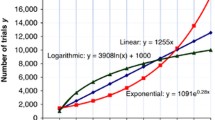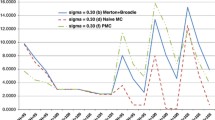Abstract
This paper extends the forward Monte-Carlo methods, which have been developed for the basic types of American options, to the valuation of American barrier options. The main advantage of these methods is that they do not require backward induction, the most time-consuming and memory-intensive step in the simulation approach to American options pricing. For these methods to work, we need to define the so-called pseudo critical prices which are used to determine whether early exercise should happen. In this study, we define a new and more flexible version of the pseudo critical prices which can be conveniently extended to all fourteen types of American barrier options. These pseudo critical prices are shown to satisfy the criteria of a sufficient indicator which guarantees the effectiveness of the proposed methods. A series of numerical experiments are provided to compare the performance between the forward and backward Monte-Carlo methods and demonstrate the computational advantages of the forward methods.









Similar content being viewed by others
References
Areal, N., Rodrigues, A., & Armada, M. R. (2008). On improving the least squares Monte Carlo option valuation method. Review of Derivatives Research, 11, 119–151.
Barone-Adesi, G., & Whaley, R. (1987). Efficient analytic approximation of American option values. Journal of Finance, 42, 301–320.
Barraquant, J., & Martineau, D. (1995). Numerical valuation of high dimensional multivariate American securities. Journal of Financial and Quantitative Analysis, 30, 383–405.
Boyle, P., Broadie, M., & Glasserman, P. (1997). Monte Carlo methods for security pricing. Journal of Economic Dynamics and Control, 21, 1267–1321.
Broadie, M., & Glasserman, P. (1997). Pricing American-style securities using simulation. Journal of Economic Dynamics and Control, 21, 1323–1352.
Broadie, M., Glasserman, P., & Kou, S. (1997). A continuity correction for discrete barrier options. Mathematical Finance, 7, 325–348.
Broadie, M., Glasserman, P., & Kou, S. (1999). Connecting discrete and continuous path-dependent options. Finance and Stochastics, 3, 55–82.
Chang, G., Kang, J., Kim, H.-S., & Kim, I. J. (2007). An efficient approximation method for American exotic options. Journal of Futures Markets, 27, 29–59.
Dai, M., & Kwok, Y. K. (2004). Knock-in American options. Journal of Futures Markets, 24, 172–192.
Duan, J. C., & Simonato, J. G. (1998). Empirical martingale simulation for asset prices. Management Science, 44, 1218–1233.
Gao, B., Huang, J., & Subrahmanyam, M. (2000). The valuation of American barrier options using the decomposition techniques. Journal of Economic Dynamics & Control, 24, 1783–1827.
Glasserman, P. (2004). Monte Carlo methods in financial engineering. New York: Springer.
Haug, E. G. (2001). Closed form valuation of American barrier options. International Journal of Theoretical and Applied Finance, 4, 355–359.
Haug, E. G. (2006). The complete guide to option pricing formulas (2nd ed.). New York: McGraw-Hill.
Kou, S. G. (2003). On pricing of discrete barrier options. Statistica Sinica, 13, 955–964.
Longstaff, F. A., & Schwartz, E. S. (2001). Valuing American options by simulation: A simple least-squares approach. Review of Financial Studies, 14, 113–147.
Miao, D. W.-C., & Lee, Y.-H. (2013). A forward Monte Carlo method for American options pricing. Journal of Futures Markets, 33, 369–395.
Ritchken,. (1995). On pricing barrier options. Journal of Derivatives, Winter 1995, 19–28.
Tilley, J. A. (1993). Regression methods for pricing complex American-style options. Transactions of the Society of Actuaries, 45, 249–266.
Acknowledgements
The authors acknowledge the support from the National Science Council of Taiwan under the grant number NSC 100-2410-H-011-006.
Author information
Authors and Affiliations
Corresponding author
Rights and permissions
About this article
Cite this article
Miao, D.WC., Lee, YH. & Wang, JY. Using forward Monte-Carlo simulation for the valuation of American barrier options. Ann Oper Res 264, 339–366 (2018). https://doi.org/10.1007/s10479-017-2639-4
Published:
Issue Date:
DOI: https://doi.org/10.1007/s10479-017-2639-4




